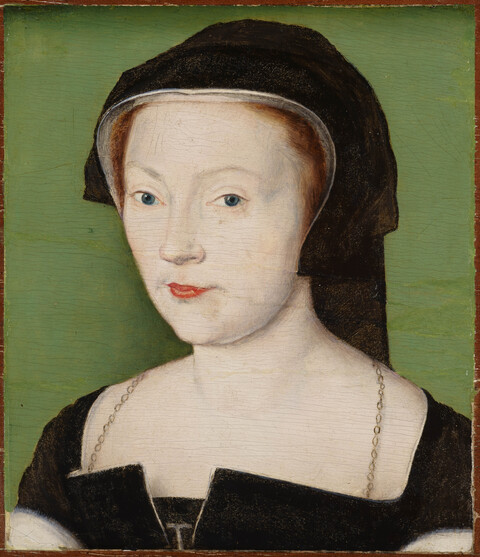Marks, Inscriptions, and Distinguishing Features
None
Entry
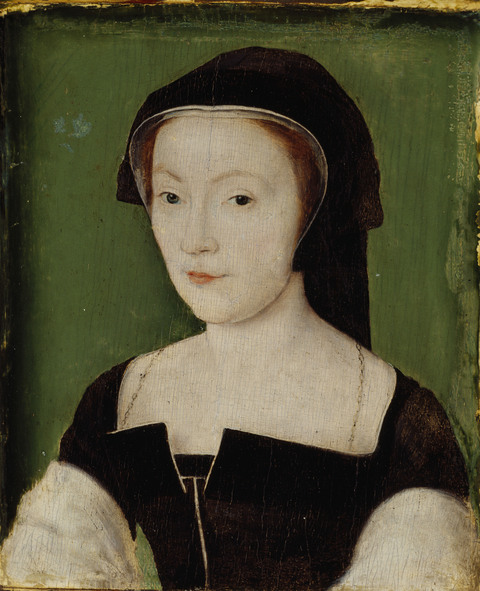
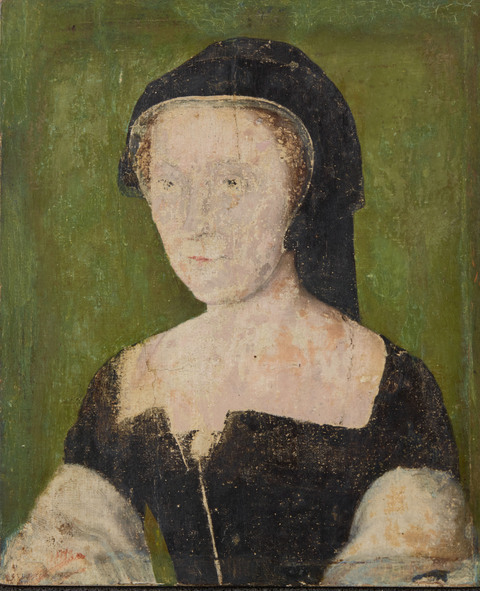
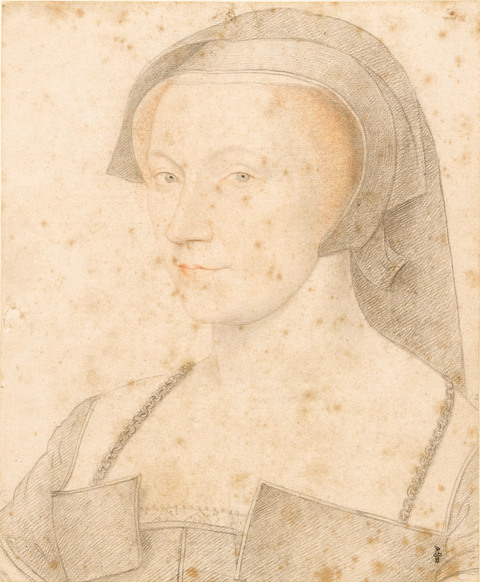
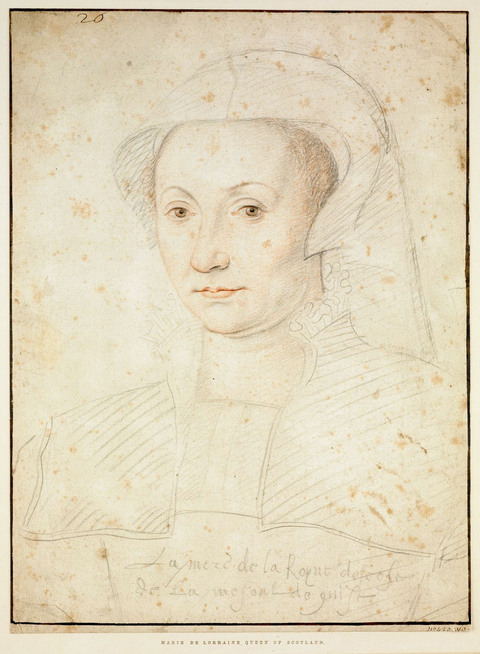
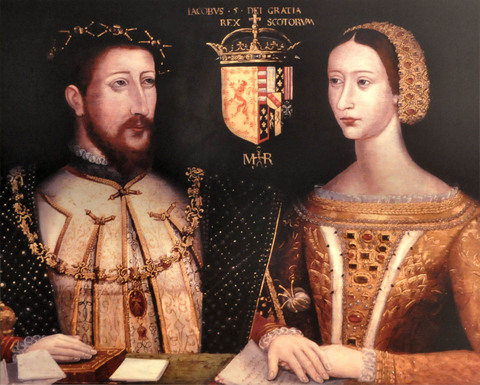
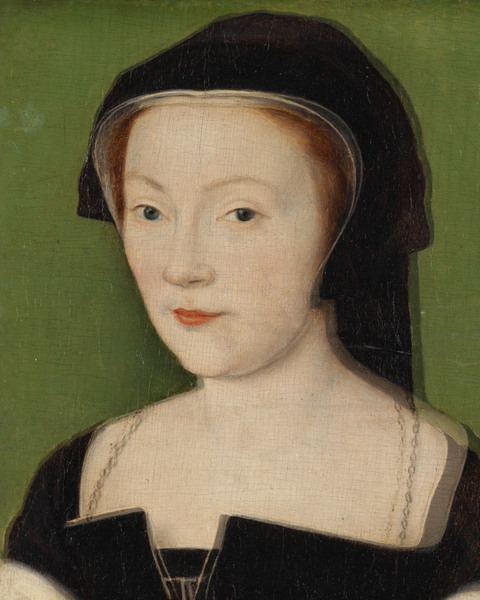
Author
Provenance
Possibly in the collection of François-Roger de Gaignières (1642–1715), Paris.16
Duke of Hamilton, Hamilton Palace;
Christie’s sale, London, in 1882;17
J. Noseda, London.18
(Jacques Seligmann et Fils, Paris) by 1937;19
Probably private collection of Germain Seligmann (1893–1978), New York;20
(Pierre F. Nesi, Beverly Hills, California, and later New York), on commission with him in 1941;21
G.H. A. Clowes, Indianapolis, in 1947;22
The Clowes Fund, Indianapolis, from 1958–2017, and on long-term loan to the Indianapolis Museum of Art since 1971 (C10027);
Given to the Indianapolis Museum of Art, now the Indianapolis Museum of Art at Newfields, in 2017.
Exhibitions
Palais National des Arts, Paris, 1937, Chefs d’Oeuvre de l’Art Francais, no. 44;
John Herron Art Museum, Indianapolis, 1950, Holbein and His Contemporaries, no. 48;
Carnegie Institute, Pittsburgh, 1951, French Paintings 1100–1900, no. 48;
John Herron Art Museum, Indianapolis, 1959, Paintings from the Collection of George Henry Alexander Clowes: A Memorial Exhibition, no. 17;
The Art Gallery, University of Notre Dame, Notre Dame, IN, 1962, A Lenten Exhibition, no. 34;
Indiana University Art Museum, Bloomington, 1963, Northern European Painting: The Clowes Fund Collection, no. 3;
Vassar College Art Gallery, Poughkeepsie, NY, 1964, Sixteenth Century Paintings from American Collections, no. 7;
Indianapolis Museum of Art at Newfields, 2019, Life and Legacy: Portraits from the Clowes Collection.
References
Chefs d’œuvre de l’art français, vol. 1: Peintures, exh. cat. with a preface by Georges Huisman (Paris: Éd. des Musée Nationaux, 1937), 82, no. 28 (reproduced);
Chefs d’œuvre de l’art français, exh. cat. (Paris: Palais National des Arts, 1937), 29, no. 44 (reproduced);
L’Illustration, 4 December 1937 (reproduced);
René Huyghe, La peinture française du XIVe au XVIIe siècle: Figures et portraits; Les Chefs-d’oeuvre de l’art français à l’Exposition internationale de 1937 (Paris: Librairie des arts décoratifs, 1937), pl. 18A;
Jacques Baschet, Pour une renaissance de la peinture française (Paris: Éditions S.N.E.P.–Illustration, 1946), 14 (reproduced);
R. O. Parks, Holbein and His Contemporaries, exh. cat. (Indianapolis: John Herron Art Museum, 1950), no. 48 (reproduced);
Charles Sterling, French Painting 1100–1900, Department of Fine Arts, Carnegie Institute, exh. cat. (Pittsburgh: Department of Fine Arts, Carnegie Institute of Art, 1951), no. 48;
Germain Seligman, Oh, Fickle Taste, or Objectivity in Art (New York: Bond Wheelwright, 1952), 119, 121, fig. 55 (reproduced);
David G. Carter, Paintings from the Collection of George Henry Alexander Clowes: A Memorial Exhibition, exh. cat. (Indianapolis: John Herron Art Museum, 1959), no. 17 (reproduced);
A Lenten Exhibition Loaned by the Clowes Fund, Inc., of Indianapolis (Notre Dame, IN: The Art Gallery, University of Notre Dame, 1962), no. 34;
Northern European Painting: The Clowes Fund Collection, exh. cat. (Bloomington: Indiana University Museum of Art, 1963), no. 5;
Sixteenth Century Paintings from American Collections, exh. cat. (Poughkeepsie, NY: Vassar College Art Gallery, 1964), no. 7.
Mark Roskill, “Clowes Collection Catalogue” (unpublished typed manuscript, IMA Clowes Archive, Indianapolis Museum of Art, Indianapolis, IN, 1968);
A. Ian Fraser, A Catalogue of the Clowes Collection (Indianapolis: Indianapolis Museum of Art, 1973), 146–147;
Anne Dubois de Groër, Corneille de la Haye, dit Corneille de Lyon (1500/1510–1575) (Paris: Arthena, 1996), 116, no. 13B (reproduced).
Technical Notes and Condition
The support is constructed from a single wooden panel with the grain horizontally aligned. Attached to the back of this is a second wooden panel, to which a cradle is affixed. This comprises five fixed horizontal and three sliding vertical members. Measurements with the cradle are 5-5/16 × 4-9/16 × 9/16 in. (13.5 × 11.6 × 1.5 cm). These dimensions include edge strips that were attached to all four sides. It is not known when these were added, but the wood is of a similar grain to the panel. The presence of these strips suggests the possibility that the panel was trimmed.
The ground appears to be a single layer of thin chalk and glue ground, and infrared reflectography shows evidence of underdrawing. According to X-radiography, past damage was sustained from major splitting in two areas along the wood grain, as well as insect damage that has caused some losses. These were treated with a lead-based fill material, and overpaint covers some areas of paint loss. The dating of previous treatment is not known; however, the presence of zinc indicates a date after 1834.
Notes
-
The identification was first proposed when the painting was in the collection of the art dealer Jacques Seligmann and exhibited in Paris in 1937; see Chefs d’œuvre de l’art français, vol. 1: Peintures, exh. cat. with a preface by Georges Huisman (Paris, 1937), 82, no. 28. ↩︎
-
Mark Roskill, “Clowes Collection Catalogue” (unpublished typed manuscript, IMA Clowes Archive, Indianapolis Museum of Art, Indianapolis, IN, 1968). See also Anne Dubois de Groër, Corneille de La Haye dit Corneille de Lyon (1500/1510–1575) (Paris: Arthena, 1996), 115–116, no. 13–13B. Provenance of the Edinburgh painting is linked to the Gaignières collection, as indicated by the mark of Colbert de Torcy on the back of the panel. It was given to the museum by E. Peter Jones in 1950. There were several portraits of Marie de Guise documented in the Gaignières collection, including the Clowes version; however, the back of the Clowes version has since been cradled and bears no marks. On the Edinburgh version, see “Corneille de Lyon, Mary of Guise, 1515–1560, Queen of James V,” accessed 3 March 2022, https://www.nationalgalleries.org/art-and-artists/3214/1402/mary-guise-1515-1560-queen-james-v. On the Versailles version, see Claire Constans, Les peintures: Musée National du Château de Versailles (Paris: Ed. de la Réunion des Musées Nationaux, 1995), 2:985, no. 5527. This painting entered the museum’s collection in 1833 during the reign of King Louis-Philippe (1773–1850). Although the catalogue entry indicates that it is a copy of the Edinburgh version, the sitter has not been identified and the work is titled Inconnue. ↩︎
-
A. Ian Fraser, 8 September 1972, File C10027, Clowes Registration Archive, Indianapolis Museum of Art at Newfields. ↩︎
-
The known portraits of Diane de Poitiers include drawings by Jean Clouet housed in Chantilly (Musée Condé, Inv. MN 201, 273, and 274, dated between 1525 and 1540), and an enamel by Leonard Limousin (about 1505–about 1575). See also the letter from Germain Seligmann to Pierre F. Nesi, 28 March 1941, Clowes Registration Files, Indianapolis Museum of Art at Newfields. On the drawings, see Alexandra Zvereva, Portraits dessinés de la cour des Valois: Les Clouet de Catherine de Médicis (Paris: Arthena, 2011), 268–269, nos. 172–174. ↩︎
-
School of Jean or François Clouet, Portrait of a Woman (Diane de Poitiers?), about 1540, Musée Condé, Chantilly, inv. MN 339 (without inscription). Raoul de Broglie, “Les Clouet de Chantilly: Catalogue illustré,” Gazette des beaux-arts 77 (1971): 257–336, 327, no. 330, as “unidentified.” Alexandra Zvereva, Portraits dessinés de la cour des Valois: Les Clouet de Catherine de Médicis (Paris: Arthena, 2011), 357, nos. 379–380 (MN 202, 203) lists two portraits that show Diane de Poitiers at about the same age as in MN 339, and are dated to about 1555. For William Suida’s assessment of this portrait, see William Suida, undated, File C10027, Clowes Registration Archive, Indianapolis Museum of Art at Newfields. ↩︎
-
For a thorough description of his working techniques, see Peter Mellen, Jean Clouet: Complete Edition of the Drawings, Miniatures, and Paintings (London: Phaidon, 1971). Also see Alexandra Zvereva, Portraits dessinés de la cour des Valois: Les Clouet de Catherine de Médicis (Paris: Arthena, 2011) on the drawings kept in Chantilly. ↩︎
-
Circle/School of François Clouet, Portrait of Marie de Lorraine, Queen of Scotland, 1522–1572, 30.2 × 22.4 cm, British Museum, London, Gg, 1.420. Inscription: Numbered “26” and titled “La mere de la Royne descose/de la mesan de guise.” Also see Anne Dubois de Groër, Corneille de La Haye dit Corneille de Lyon (1500/1510–1575) (Paris: Arthena, 1996), 115. A copy of this drawing is in Fécamp, Musée des Arts et de l’Enfance, FEC. 31 (33.7 × 21.9 cm). See Xavier Salmon and Philippe Malgouyres, Catalogue raisonné des dessins anciens du Musée Centre-des-Arts de Fécamp (Fécamp: Musée-centre des arts, 1994), 82–83, no. 27. ↩︎
-
Arthur B. Chamberlain, Hans Holbein the Younger (London: G. Allen & Co., 1913), 2:139–140. ↩︎
-
In 1537/38, King Henry II sent a representative to France to meet with Marie de Guise for negotiations and probably also to obtain her portrait on this occasion. This led the historian Arthur Chamberlain to speculate as to whether Holbein may have been charged to paint her portrait, since he was sent to Le Havre and Joinville, France, the same year and painted the portrait of Marie’s younger sister Louise de Guise. Arthur B. Chamberlain, Hans Holbein the Younger (London: G. Allen & Co., 1913), 2:142–155, especially 143–144. ↩︎
-
Biographical information is based upon Rosalind K. Marshall, “Mary of Guise,” in Oxford Dictionary of National Biography, vol. 36 (Oxford: Oxford University Press, 2004), 71–77, with complete bibliography. ↩︎
-
The four versions are listed as follows in Anne Dubois de Groër, Corneille de La Haye dit Corneille de Lyon (1500/1510–1575) (Paris: Arthena, 1996), 115–16, nos. 13–13C. No. 13, Marie de Lorraine, 15.3 × 12.7 cm, The National Portrait Gallery, Edinburgh, Inv. 1558; no. 13A, Marie de Lorraine, 16 × 13 cm, Musée national du château, Versailles, MV 3148; no. 13B, Marie de Lorraine [sic], 14 × 10.5 cm [sic], The Clowes Collection, Indianapolis Museum of Art at Newfields, Indianapolis, C10027; no. 13C, Marie de Lorraine, 13 × 11 cm, Collection of the Duke of Buccleugh (A fourth, sold in Paris, Hôtel Drouot, 4–5 February 1954, no. 85 is incorrectly identified as no. 13C among the replicas on p. 115). ↩︎
-
Anne Dubois de Groër, Corneille de La Haye dit Corneille de Lyon (1500/1510–1575) (Paris: Arthena, 1996), 115. ↩︎
-
Edinburgh: 15.3 × 12.7 cm; Versailles: 16 × 13 cm. For technical analysis of the Clowes painting, see the Technical Examination Report. ↩︎
-
Dubois de Groër suggests the possibility that Corneille de Lyon worked without preparatory drawings; however, she acknowledged that this practice only starts to occur in the seventeenth century. See Anne Dubois de Groër, Corneille de La Haye dit Corneille de Lyon (1500/1510–1575) (Paris: Arthena, 1996), 40. Also see Cécile Scailliérez, “Des petits portraits au naturel, qu’on nomme cornilla,” in Ludmila Virassamynaïken, ed., Arts et Humanisme: Lyon Renaissance (Lyon: Musée des Beaux-Arts/Paris: Somogy, 2015), 149, who has also suggested that Corneille de Lyon worked without preparatory designs and copied the versions more or less exactly. ↩︎
-
Anne Dubois de Groër, Corneille de La Haye dit Corneille de Lyon (1500/1510–1575) (Paris: Arthena, 1996), 40–41. See also Cécile Scailliérez, “Des petits portraits au naturel, qu’on nomme cornilla,” in Ludmila Virassamynaïken, ed., Arts et Humanisme: Lyon Renaissance (Lyon: Musée des Beaux-Arts/Paris: Somogy, 2015), 150–151. ↩︎
-
The inventory of the Gaignières collection, made in 1711, was first published by Charles Loizeau de Grandmaison, “Charles Gaignières, ses correspondants et ses collections de portraits [troisième article]. Appendice” in Bibliothèque de l’école des chartres, 53 (1892), 5–76, and contains several portraits of Marie de Guise (“Marie de Lorraine”). Dubois de Gröer’s catalogue raisonné lists four versions of this portrait; see Anne Dubois de Gröer, Corneille de La Haye, dit Corneille de Lyon (1500/1510–1575) (Paris: Arthena, 1996), nos. 13-13C. The Clowes version, no. 13B, is supported by a modern cradle, with no trace of the red wax seal of Colbert de Torcy. ↩︎
-
The Hamilton Palace Collection, sale cat., Christie’s, London, 15 July 1882, no. 1653 as “Lady of the time of Francis I, by Janet.” ↩︎
-
The catalogue of the 15 July 1882 auction notes that “J. Noseda” purchased no. 1653, as well as other portraits of royalty in this sale. This is likely to be a reference to Jane Noseda (1813/14–1894) who was primarily a print dealer. On the Noseda family of dealers, see Mark Westgarth, “A Biographical Dictionary of Nineteenth Century Antique and Curiosity Dealers” in Regional Furniture: The Journal of the Regional Furniture Society, 23 (2009), 143–4. ↩︎
-
Jacques Seligmann et Fils, Paris, is listed as the owner in Chefs d’Oeuvres de l’Art français, exh. cat. (Paris: Palais National des Arts, 1937), no. 44. ↩︎
-
See Letter from Nesi to G.H.A. Clowes, 8 May 1947, Clowes Registration Archive, Indianapolis Museum of Art at Newfields, and File G.H. A. Clewes [sic], Box 180, Folder 6, Jacques Seligmann & Co. Records, Archives of American Art. ↩︎
-
See Letter from Seligmann to Nesi, 28 March 1941, Clowes Registration Archive, Indianapolis Museum of Art at Newfields. ↩︎
-
See Bill of sale from Nesi to G.H.A. Clowes, 16 January 1947, Clowes Registration Archive, Indianapolis Museum of Art at Newfields. ↩︎
